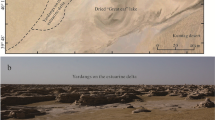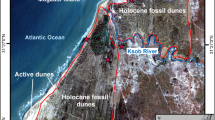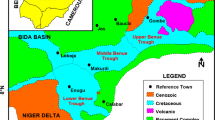Abstract
Widespread aeolian sediments have been found in the middle reaches of the Yarlung Zangbo River, China. The grain-size characteristics of sediments from Cha’er Section in the area were analyzed. The results show that the section include one stratum of paleo-mobile dunes, four strata of paleo-semi-fixed dunes, two strata of paleo-fixed dunes, one stratum of sandy immature soils. The paleo-mobile and paleo-semi-fixed dune sand in this section are similar to modern aeolian sand in either grain-size composition or Mz and δ distribution. Compared the above types of dunes each other, the content of sand substance decreases, while the content of silt and clay increases for paleo-fixed dunes and sandy immature soils. Combined with age data for each stratum, the analysis shows that these strata are the products of climate changes and the evolution of aeolian landforms. The evolutionary sequence of the paleoclimate and of aeolian activities in the valley since 8600 yr B.P. reveals four stages: 8600–5700 yr B.P., when the paleoclimate was cold and dry, with strong winds, thereby activating dunes; 5700–3600 yr B.P., when it was warm and wet, with weak winds, causing dunes to undergo soil-forming processes; 3600–1900 yr B.P., when climate shifted from cold-dry with strong winds to warm-wet with weak winds, and activated dunes were fixed again; and 1900 yr B.P. -present, when the climate became fine, with weak winds, fixing dunes again.
Similar content being viewed by others
References
CSEQXP-CAS (Comprehensive Scientific Expedition to the Qinghai-Xizang Plateau, Chinese Academy of Sciences), 1988. Physical Geography of Xizang (Tibet). Beijing: Science Press, 150–159. (in Chinese)
Chang Chunping, Zou Xueyong, Zhang Chunlai et al., 2006. The characteristics and distribution of the source area of aeolian sand in the valley of Lhasa River’s lower reaches, Tibet, China. Journal of Mountain Science, 24(04): 489–497. (in Chinese)
Dong Guangrong, Gao Shangyu, Jin Jiong et al., 1993. The Desertification and its Control in the Gonghe Basin, Qinghai Province. Beijing: Science Press, 59–142. (in Chinese)
Folk R L, 1966. A review of grain-size parameters. Sedimentology, 6(2): 73–93. DOI: 10.1111/j.1365-3091.1966.tb01572.x
Gao Shangyu, Chen Weinan, Jin Heling et al., 1993. A preliminary study on desert evolution in the northwestern fringe of monsoon area, China. Science in China (Series B), 23(2):202–208. (in Chinese)
Jin Heling, Dong Guangrong, Li Sen et al., 1996. The climate and southwest monsoon change in the middle “one river two tributaries” basin, Tibet since 0.80 Ma B.P. Journal of Desert Research, 16(1): 9–12. (in Chinese)
Jin Heling, Dong Guangrong, Liu Yuzhang et al., 1998. The sandfield evolution and climatic changes in the middle course area of Yarlung Zangbo River in Tibet, China since 0.80 Ma B.P. Journal of Desert Research, 18(2): 97–104. (in Chinese)
Jin Heling, Dong Guangrong, Zhang Chunlai, 2000. Deposition features and causes of Loess in Yarlung Zangbo River Valley area. Journal of Desert Research, 20(1): 14–19. (in Chinese)
Jin Heling, Dong Guangrong, Su Zhizhu et al., 2001. Reconstruction of the spatial patterns of desert/loess boundary belt in North China during the Holocene. Chinese Science Bulletin, 46(12): 969–975.
Li Sen, Sun Wu, Li Xiaoze et al., 1995. Sedimentary characteristics and environmental evolution of Otindag sandy land in Holocene. Journal of Desert Research, 15(4): 323–331. (in Chinese)
Li Sen, Dong Guangrong, Shen Jianyou et al., 1999. Formation mechanism and development pattern of aeolian sand landform in Yarlung Zangbo River valley. Science in China (Series D), 42(3): 272–284. DOI: 10.1007/BF02878964
Liu Lianyou, Liu Zhimin, Zhang Jiashen et al., 1997. Sand source of sand dune and modern desertification process in Jiandang wide valley area of Yarlung Zangbo River. Journal of Desert Research, 17(4): 377–382. (in Chinese)
Lu Huayu, An Zhisheng, 1997a. Paleoclimate significance of grain size in Luochuan loess-palaeosol series. Chinese Science Bulletin, 42(1): 66–69. DOI: 10.1007/BF02878745
Lu Huayu, An Zhisheng, 1997b. Pretreatment methods in loess-palaeosol granulometry. Chinese Science Bulletin, 42(23):237–240. DOI: 10.1007/BF02898920
North Shaanxi Team of Chengdu College of Geology, 1976. Grain-Size Analysis of Sediment and Its Application to Engineering. Beijing: Geological Publishing House, 42–51. (in Chinese)
Sun Jimin, Li Shenghua, Daniel R M, 2007. Loess sedimentation in Tibet: provenance, processes, and link with Quaternary glaciations. Quaternary Science Reviews, 26(17): 2265–2280. DOI: 10.1016/j.quascirev.2007.05.003
Thompson L G, Yao Tandong, Davis M E et al., 1997. Tropical climate instability: The last glacial cycle from a Qinghai-Tibetan ice core. Science, 276(5320): 1821–1825. DOI: 10.1126/science.276.5320.1821
Wang Hua, Hong Yetang, Zhu Yongxuan et al., 2003. The peat humification records of Holocene climate change in Hongyuan Region. Geology Geochemistry, 31(2): 51–56. (in Chinese).
Wang Ninglian, Yao Tandong, Thompson L G et al., 2002. Evidence for cold events in the early Holocene from the Guliya icecore, Tibetan Plateau, China. Chinese Science Bulletin, 47(17): 1422–1427. DOI: 10.1360/02tb9313
Wang Shaowu, Huang Jianbin, Wen Xinyu et al., 2008. Evidence and modeling study of droughts in China during 4–2 ka BP. Chinese Science Bulletin, 53(14): 2215–2221. DOI: 10.1007/s11434-008-0303-8
Wu Zheng, 1987. Aeolian Geomorphology. Beijing: Science Press, 279–292. (in Chinese)
Zhu Kezhen, 1973. A preliminary study on the climate changes since the last 5000 years in China. Science in China (Series A), (2): 168–189. (in Chinese)
Zhu Liping, Wu Yanhong, Wang Junbo, et al., 2008. Environmental changes since 8.4 ka reflected in the lacustrine core sediments from Nam Co, central Tibetan Plateau, China. The Holocene, 18(5): 831–839. DOI: 10.1177/0959683608091801
Author information
Authors and Affiliations
Corresponding author
Additional information
Foundation item: Under the auspices of National Natural Science Foundation of China (No. 40671185), National Key Technologies R&D Program of China (No. 2006BAD26B03)
Rights and permissions
About this article
Cite this article
Zheng, Y., Wu, Y., Li, S. et al. Grain-size characteristics of sediments formed since 8600 yr B.P. in middle reaches of Yarlung Zangbo River in Tibet and their paleoenvironmental significance. Chin. Geogr. Sci. 19, 113–119 (2009). https://doi.org/10.1007/s11769-009-0113-1
Received:
Accepted:
Published:
Issue Date:
DOI: https://doi.org/10.1007/s11769-009-0113-1




